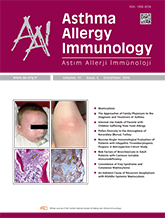


Objective: Asthma is a chronic inflammatory disease. Clinical findings in repeated attacks are cough, wheezing, respiratory difficulty, and airway obstruction. The first and most important stage in the control of asthma is the family physician. The aim of this study was to determine the level of knowledge of family physicians on asthma and to raise awareness on the subjects of diagnosis and treatment of asthma.
Materials and Methods: The study was implemented with the voluntary participation of 210 family physicians. A pre-prepared questionnaire was completed in face-to-face interviews. The questionnaire had been prepared with the aim of measuring the skills of family physicians in diagnosing and treating asthma patients. With the correct answers provided, it was examined whether or not there was a relationship with the duration of professional experience of the family physicians. The participants were evaluated in two groups, those with 1-10 years of professional experience and the ones with 11-30 years of experience.
Results: A total of 210 family physicians were evaluated in the study, comprising 124 (59%) males and 86 (41%) females, with a mean age of 38.28±7.76 years. The group with 1-10 years of professional experience comprised 45 (52.3%) males and 41 (47.7%) females, with a mean age of 30.84±3.03 years. Those with 11-30 years of experience comprised 79 (63.7%) males and 45 (36.3%) females, with a mean age of 43.44±5.51 years. A statistically significant difference was determined between the groups of less and more experience in only three items: `asthma symptoms recover with bronchodilator drugs` (p=0.011), `I treat children with an acute attack of asthma with nebulizer bronchodilator treatment` (p=0.040), and `I do not feel confident to start treatment for any patient that I think has asthma`(p=0.019).
Conclusion: Increasing the confidence of family physicians and encouraging them to increase their levels of knowledge on the subjects of diagnosis of asthma and especially acute and preventative treatment could contribute to better control of this disease, which causes high morbidity and mortality.